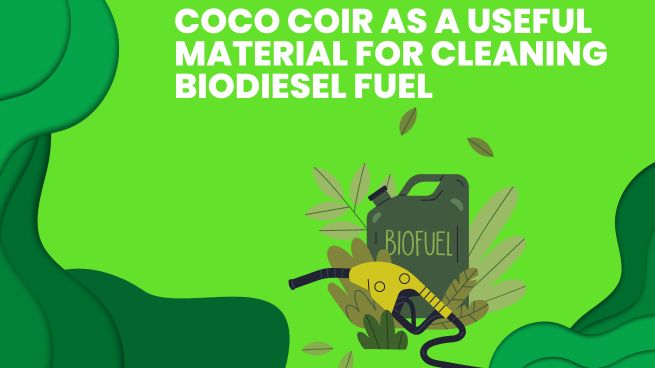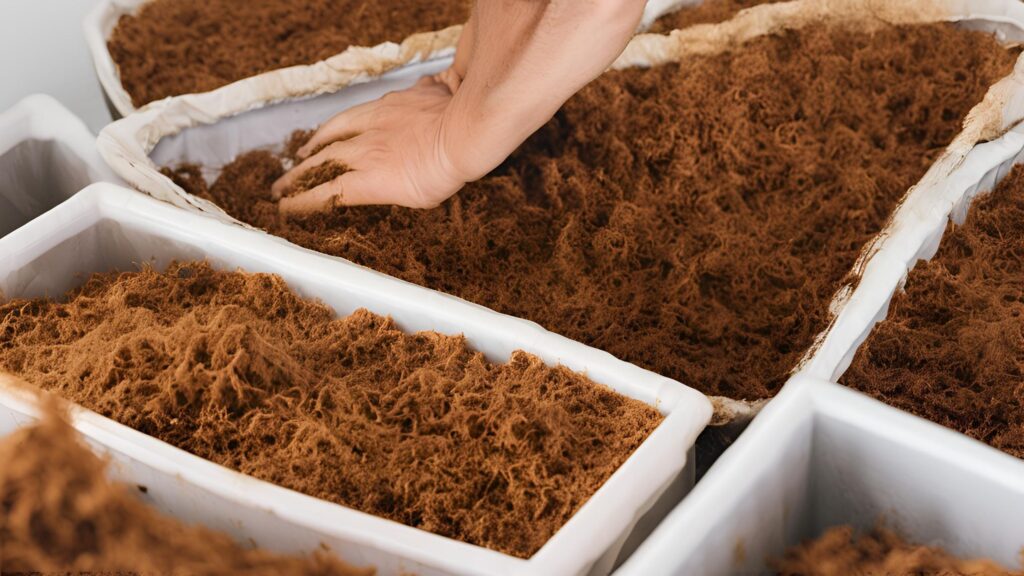
Worried about air quality?
Biodiesel can help, but it needs a sustainable cleaning process.
Environmental conservation is a complex task, but it’s also an area full of exciting possibilities. Reducing pollution is not a solitary path but is filled with innovative ideas. One such idea is using biodiesel, which is promising for our environment.
In 2022, India’s biodiesel production reached 185 million liters, and it’s expected to increase slightly in 2023. The Indian government aims for 5% of all fuel to be biodiesel by 2030, meaning India will need to produce about 4.5 billion liters of biodiesel annually.
Biodiesel needs to be clean to be effective. Researching new ways to clean biodiesel is important because it helps make biodiesel better for the environment.
Coco coir, a byproduct of coconut husks, is a natural resource with significant potential. According to the Food and Agriculture Organization, approximately 61 million metric tons of coconuts were produced worldwide in 2021, making coco coir abundant.
In this blog, we will discuss how coco coir can be used for cleaning biodiesel and how it can support sustainability. Using coco coir in this manner can make biodiesel production more eco-friendly.
What Is Biodiesel?
Biodiesel is a fuel made from living things, like vegetable oil from plants or used cooking oil. It’s like a clean-burning cousin to regular diesel fuel that powers trucks and buses. Biodiesel is renewable because we can always grow more plants or collect more used cooking oil. It’s also better for the environment because it doesn’t pollute as much as regular diesel.
How Can Coco Coir Clean Biodiesel?

Coco coir effectively cleans biodiesel through its natural adsorption properties. When mixed with biodiesel, coco coir absorbs impurities like glycerol and methanol, improving fuel purity. Its porous structure provides a large surface area for contaminants to adhere to, allowing easy separation from the biodiesel.
Coco coir is also biodegradable, making it an environmentally friendly option for biodiesel purification. Its use offers a sustainable and cost-effective method for enhancing biodiesel quality while reducing environmental impact.
Research on coco coir for biodiesel purification is emerging but limited. Some studies suggest promise. One investigation showed that coco coir effectively reduced soap content in biodiesel, a key purification step. This aligns with research on other natural materials like banana peels and mushrooms.
However, there is a lack of in-depth studies comparing coco coir’s effectiveness to established purification methods. Moreover, research has not been conducted into the optimal coir processing for biodiesel’s purification process or its reusability.
More research is needed to determine coco coir’s overall efficiency in removing impurities and its impact on biodiesel quality compared to standard methods. Investigating ways to optimize coir for this purpose and exploring its reusability would be important for making it a sustainable biodiesel purification option.
Challenges and Considerations on Using the Coco Coir
While coco coir offers numerous benefits for biodiesel cleaning, some challenges and considerations exist. Variability in coco coir quality and composition can affect its adsorption efficiency, requiring careful selection and testing.
In Addition, the regeneration process to restore its adsorption capacity may require energy and resources. Proper disposal or recycling methods must be ensured to prevent environmental contamination.
Furthermore, transportation logistics for sourcing coco coir may pose challenges, especially in landlocked regions. Informing these factors is essential for maximizing the effectiveness and sustainability of using coco coir in biodiesel cleaning.
Proper selection and processing of coco coir are vital for optimal performance in biodiesel cleaning. Variations in coir quality, such as particle size, moisture content, and fibre composition, directly influence its adsorption capacity and efficiency. Manufacturers can ensure consistent and reliable performance through various testing and quality control measures.
Appropriate processing techniques, such as washing and drying, help remove impurities and improve the coir’s adsorption properties. Investing in quality assurance measures is crucial for maximizing the effectiveness of coco coir in biodiesel purification.
Guide for using the Coco Coir for cleaning the Bio Diesel from Cocopeat

-
Coco coir, a natural fiber from coconut husks, effectively purifies biodiesel, especially when derived from cocopeat.
-
Start by selecting untreated, high-quality coco coir to avoid contamination.
-
Wash and dry the coir thoroughly to remove salts and organic matter before use.
-
Pack the coir evenly into a filtration setup for maximum contact with biodiesel.
-
The micro-porous structure of coco coir acts as a natural filter, absorbing impurities and moisture from biodiesel.
-
As biodiesel flows through, coir traps impurities like glycerin, soaps, and residual catalysts, resulting in a cleaner product.
-
Maintain a slow, consistent flow rate of biodiesel through the coir for effective purification.
-
Monitor the output for clarity and quality, adjusting flow rate or replacing coir as needed.
-
Periodically wash and dry or replace the coir to maintain its filtering efficiency.
-
Using coco coir supports sustainability by repurposing coconut waste in biodiesel production.
-
It exemplifies a resourceful approach to sustainable energy practices, maximizing natural material utility.
Future Developments and Applications
- Future developments and applications of coco coir for biodiesel hold significant promise. Researchers are finding new ways to optimize coco coir’s adsorption properties, potentially through surface modification or mixing with other materials.
- Additionally, advancements in processing techniques may improve coir’s efficiency in removing specific impurities from biodiesel, enhancing overall fuel quality. Moreover, innovative approaches such as using spent coir for value-added products will contribute to a more sustainable and circular economy.
- Continued research and development efforts will likely help to open new opportunities for utilizing coco coir in biodiesel production, driving innovation and environmental safety in the renewable energy sector.
- Coco coir has potential applications in biogas, bioethanol, and bio-based chemical production due to its fibrous structure and ability to support microbial growth.
Final Words
Cleaning biodiesel using coco coir is an efficient and eco-friendly method that leverages the natural filtering properties of coconut fibers. By thoroughly washing and drying the coir before use, and maintaining a consistent flow rate during filtration, biodiesel can be effectively purified from impurities such as glycerin, soaps, and residual catalysts. This process not only enhances the quality and performance of biodiesel but also promotes sustainability by utilizing natural waste products.
Regular maintenance and replacement of the coir ensure ongoing filtration efficiency, making it a reliable option for long-term use. Overall, employing coco coir for biodiesel purification is a resourceful and environmentally conscious approach, supporting cleaner energy production and sustainable practices.
Frequently Asked Questions:
1. Can coco coir really clean biodiesel fuel?
Yes, coco coir effectively filters impurities from biodiesel, enhancing its quality and promoting sustainable energy practices.
2. Is coco coir the future of biodiesel cleaning?
Coco coir shows promise as a sustainable and effective option for biodiesel cleaning, but further research and development are needed to determine its widespread applicability and efficiency.
3. Are there other ways to clean biodiesel fuel?
Yes, alternative methods for cleaning biodiesel include chemical treatments, such as acid or base washing, and mechanical processes like centrifugation or filtration using different types of media.
